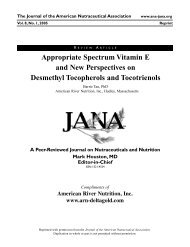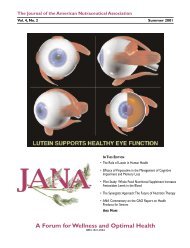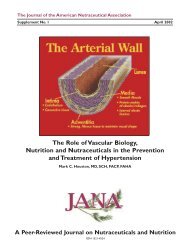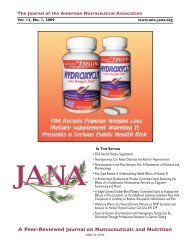JANA Vol 9 #1 - American Nutraceutical Association
JANA Vol 9 #1 - American Nutraceutical Association
JANA Vol 9 #1 - American Nutraceutical Association
You also want an ePaper? Increase the reach of your titles
YUMPU automatically turns print PDFs into web optimized ePapers that Google loves.
SNPs can occur in both coding (gene) and noncoding<br />
regions of the genome. Many SNPs have no effect on cell<br />
function, but scientists believe others could predispose people<br />
to disease or influence their response to a drug. Almost<br />
500 polymorphisms have been identified as having clinical<br />
importance, and their penetrance affects the expression of<br />
disease in the affected individual.<br />
The mapping of the human genome has provided insight<br />
into the relationship of genes, enzymes, cofactors, substrates,<br />
and metabolites. We have now acquired the tools to analyze<br />
the information flow from the genome (genomics) via protein<br />
translation (proteomics), and from the metabolite network<br />
and fluxes (metabolomics) to the human phenotype.<br />
Combined with the understanding of the biochemical pathways<br />
in human metabolism, we now can also assess especially<br />
the impact of nutrients on this interrelated complex<br />
metabolic network spanning from genome to phenotype.<br />
Epidemiological studies conducted over the last 25<br />
years that compare dietary patterns (i.e. intake of particular<br />
food items) between countries of low and high incidence for<br />
a particular cancer5-6 provided the first clues that diet and<br />
the consumption of certain nutrients may be a risk factor in<br />
the development of cancer and chronic diseases through<br />
interaction with the individual genome. Almost eighty percent<br />
of colon, breast, and prostate cancer cases and one<br />
third of all cancer cases may be influenced by diet and associated<br />
lifestyle factors. Dietary factors that influence the<br />
expression of cancer genes include carbohydrates, amino<br />
acids, fatty acids, minerals, and vitamins. Many other nutrients<br />
that modulate the genetic expression include phytochemicals<br />
and other components of a plant and fruit-based<br />
diet including carotenoids, flavonoids, organosulfur compounds,<br />
isothiocyanates, indoles, monoterpenes, phenolic<br />
acids, and chlorophyll. 7<br />
The penetrance or expression of cancer genes is strongly<br />
influenced by the interaction of both genetic and environmental<br />
influences. The evidence for this is based on<br />
studies of human populations as well as from animal experiments<br />
that model the process of carcinogenesis. 8 Some<br />
large-scale intervention trials indicated that single nutrients<br />
cannot explain the beneficial effect of diet on gene expression.<br />
For example, strong epidemiologic evidence linking<br />
consumption of carotenoid-rich fruits and vegetables with a<br />
reduced risk of cancer could not be verified by two other<br />
large-scale ß-carotene intervention trials. 9-10 These trials were<br />
conducted with populations of smokers and asbestosexposed<br />
individuals, revealing that the risk of lung cancer<br />
increased rather than decreased in the groups supplemented<br />
with ß-carotene. The trial outcomes mainly reaffirm the<br />
hypothesis that multiple phytonutrients and not single nutrients<br />
affect the genetic expression and penetrance that<br />
results in the development of cancer and other chronic disease.<br />
Multicenter and projective cohort studies were conducted<br />
in Europe to explore the apparent complex relation-<br />
ship of nutrition and cancer. The European Prospective<br />
Investigation into Cancer and Nutrition (EPIC), was<br />
designed to investigate the relationships between diet, nutritional<br />
status, lifestyle and environmental factors, and the<br />
incidence of cancer and other chronic diseases. 11 EPIC is<br />
the largest study of diet and health ever undertaken, having<br />
recruited over half a million people in ten European countries:<br />
Denmark, France, Germany, Greece, Italy, the<br />
Netherlands, Norway, Spain, Sweden, and the United<br />
Kingdom. Preliminary results of these large and well-conducted<br />
prospective EPIC studies published in 2005 indicated<br />
the absence of association between fruit and vegetable<br />
intake and incidence of breast cancer. 12 The authors emphasize<br />
that a small benefit can never be excluded and a modest<br />
benefit could exist for a subgroup of women (perhaps<br />
defined by genetic factors) or a subset of cases (for example,<br />
defined by estrogen receptor status). An important limitation<br />
is the lack of data on diet during childhood. If constituents<br />
of fruits and vegetables are acting to protect DNA<br />
from damage during childhood, nutritional intervention in<br />
utero and during early childhood may be a crucial factor in<br />
the phenotypic expression of cancer, and published studies<br />
could have entirely missed the critical periods.<br />
Although the findings on fruit and vegetable consumption<br />
and cancer may be disappointing, the epidemiological<br />
evidence clearly points towards lower risks of cardiovascular<br />
disease (CVD). The observation that dietary components<br />
such as saturated fatty acids are strongly correlated with the<br />
incidence of CVD in certain individuals but not in others<br />
points towards the genetic variations among individuals.<br />
CVD is a classic example of a diet-related chronic disease<br />
claiming more lives each year than the next 4 leading causes<br />
of death combined, which are cancer, chronic lower respiratory<br />
diseases, medical accidents, and diabetes mellitus. 13<br />
Preliminary mortality data show that CVD as the underlying<br />
cause of death accounted for 37.3% of all 2,440,000<br />
deaths in 2003 or 1 of every 2.7 deaths in the United States.<br />
CVD as an underlying or contributing cause of death<br />
(1,408,000 deaths in 2002) was about 58% of all deaths that<br />
year. Since 1900, CVD has been the no. 1 killer in the<br />
United States every year but 1918. Nearly 2,500 <strong>American</strong>s<br />
die of CVD each day, an average of 1 death every 35 seconds.<br />
In addition, the aging of our population will result in<br />
an increased incidence of chronic CVD, including coronary<br />
artery disease (CAD), heart failure (CHF), and stroke. 14<br />
CVD is now understood to be an inflammatory disorder,<br />
and the relation between CVD and inflammation demonstrates<br />
the correlation between genes and nutrition factors.<br />
15 Current dietary recommendations for the prevention<br />
of CVD are derived from population-based epidemiological<br />
and observational studies and focus on the reduction of<br />
known cardiovascular risk factors such as low levels of<br />
HDL cholesterol and elevated levels of LDL cholesterol.<br />
The successful sequencing of the human genome and<br />
2 <strong>JANA</strong> <strong>Vol</strong>. 9, No. 1, 2006









